0056 I repeat. Here is a table that colors in the hypothesis of the coincidence between a sequence of novel presentative forms and grounding of transcendence, with one diagonal strand colored in bold.
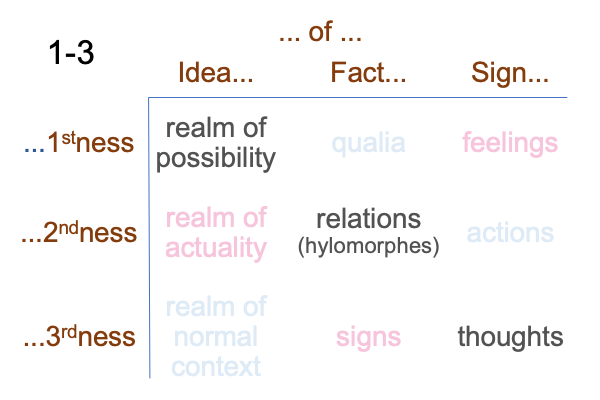
0057 First, I associate two contiguous elements, ‘something’ in the realm of possibility (presentative) and hylomorphic relations or things (form) to Heidegger’s term, Moglichkeit. ‘Something’ (presentation, idea in firstness) substantiates a thing (form, fact in secondness).
Kemple elaborates in section 6.3.1. Heidegger identifies the dimensions of Moglichkeit (possibility) as Shiften (translated as establishing, finding, causing, as well as inducing) and Weltenwurf (translated as projection of world).
0058 What do these dimensions suggest?
Following the argument of the previous blog, the presentation of Moglichkeit rests primarily in firstness, rather than the idea of firstness and the form of Moglichkeit rests in secondness, rather that the fact of hylomorphic relations.
That would associate Moglichkeit with a contiguity between firstness and secondness, more or less mirroring the relation between contenta and situationb-level actualities2 for a two-level interscope.
0059 If this association to Moglichkeit is plausible, then the presentation of Ausweisen rests primarily in secondness (the row), rather than the fact of secondness (the column), and the form of Ausweisen touches base with thirdness (the row), instead of signs of thirdness (the column). Maybe, I should say, essentially with thirdness, and accidentally with signs of thirdness.
How to translate the term, Ausweisen? Kemple recommends the term, “pointing out”, while other translators choose the term, “account”. “Pointing out” distinguishes an object from its surroundings. An object is “laid out in consciousness”.
Finally, Boden (surroundedness) connects thirdness (the row) with firstness (the row) in the same manner as Moglichkeitand Ausweisen. The presentation belongs to row 3 and column N. The form belongs to row 1 and column N+1, unless N+1 equals four, then the column returns to idea (the form of firstness).
Here is the summary for the ongoing diagonal.
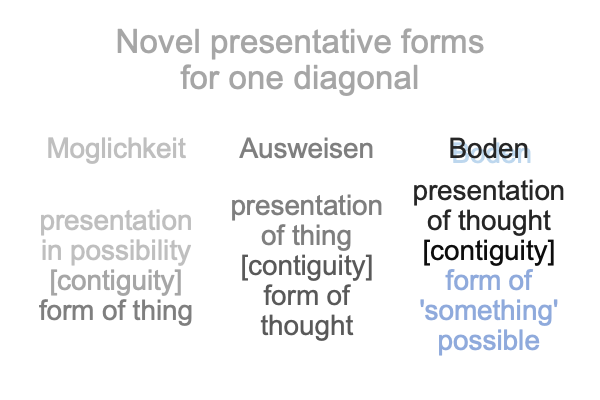
0060 Does Moglichkeit, Ausweisen and Boden associate to pairs of elements in a sign relation?
Here is a guess.
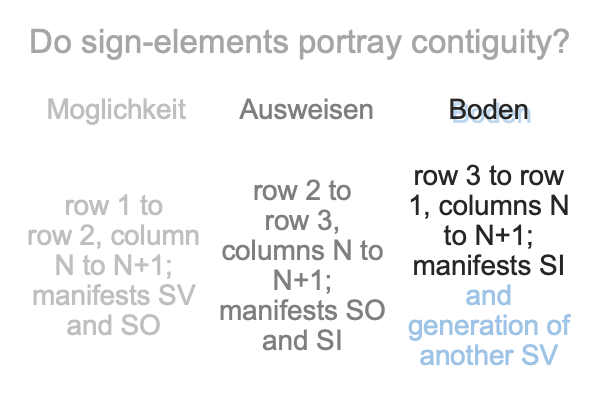
0061 For Moglichkeit, the sign-vehicle (SV) associates to novel presentation in firstness (row) and the sign-object (SO) associates to novel form in secondness (row). The columns shift as well.
For Ausweisen, the SO associates to novel presentation in secondness (row) and the SI associates to novel form in thirdness (row). The columns shift as well.
For Boden, the sign-interpretant (SI) associates to novel presentation in thirdness (row) and a corresponding nacent SV associates to novel form in firstness (row). The columns shift as well. The nascent SV may sustain the next Moglichkeit.
0062 Here is a picture of how sign-elements key into the tabular presentative forms along one diagonal.
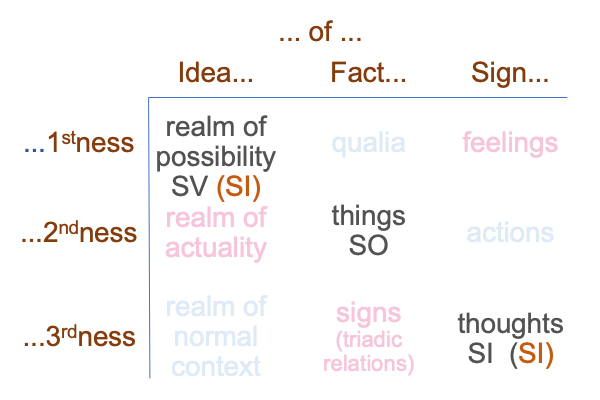
Each novel presentative form expresses the tabular presentative form (row M, column N) [contiguity based on the two manifesting sign elements] the tabular presentative form (row M+1, column N+1), with wrap-around from thirdness to firstness.
0063 Here is a picture of the flow of Heidegger’s terms and how they might associate to the elements of Peirce’s sign-relation for this particular diagonal.
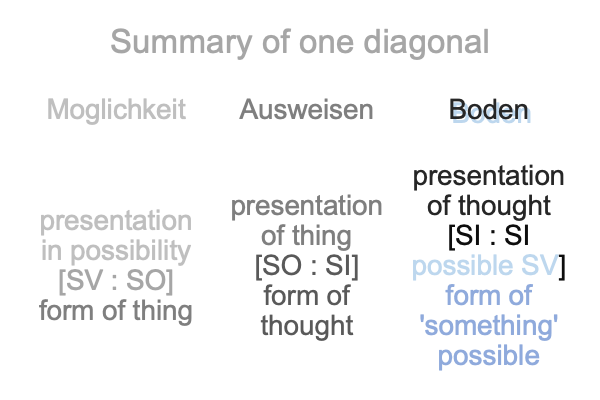
0064 In general, Moglichkeit moves diagonally from the first to the second row and associates to a hylomorphic structure crossing from firstness to secondness. A sign-vehicle makes a sign-object possible.
Ausweisen moves diagonally from the second to the third row and associates to a hylomorphic structure crossing from secondness to thirdness. A sign-object points to the facet of a sign-interpretant in thirdness.
Boden wraps around diagonally from the third to the first row and associates to a hylomorphic structure crossing from thirdness to firstness. The facet of the sign-interpretant in thirdness joins with the facet of the sign-interpretant in firstness.
0065 So far, I suggest that Heidegger’s grounding of transcendence corresponds to novel presentative forms.
Plus, these novel presenatitive forms further correspond to elements in a sign relation.
In the previous figure, couplings of sign-elements label the contiguity between the two tabular presentative forms that contribute to the novel presentative form.
0066 If these associations make sense, then I may claim the following.
Heidegger’s grounds of transcendence may be technically written as a novel presentation [substantiates] form. Plus, the novel presentation belongs to one category (foremost in appearance (row) and secondarily in experience (column)) and the novel form belongs to the adjacent higher category (for both row and column, with wrap around).
A sequence of dyads may be depicted by focusing on diagonals in a table of appearances versus forms. A table of presentative forms contains nine ” presentative forms” (or better, “tabular presentative forms”) according to the current normative use of the term, and supports three sequences of “novel presentative forms”. Each sequence associates to Heidegger’s three terms describing the grounds of transcendence.
0067 Finally, the contiguity between novel presentation and novel form along one particular diagonal juxtaposes two elements within a sign relation.
